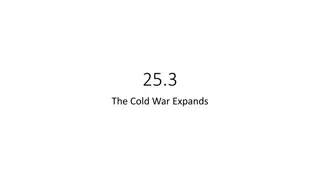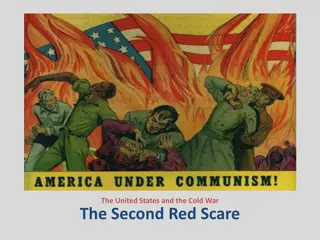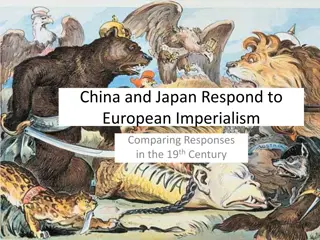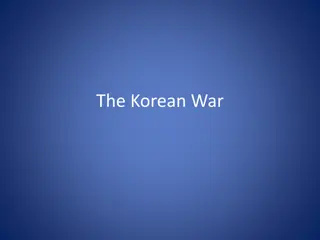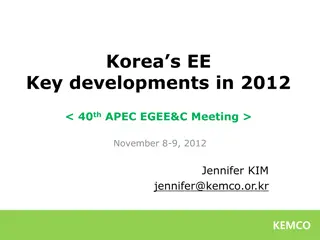The Cold War Heats Up: Korea and China Conflict
The post-World War II era saw the U.S. engaging in the Korean War to combat communism, facing off against North Korea and China instead of Russia. Conflict in China between the Nationalists led by Chiang Kai-shek and the Communists under Mao Tse-tung intensified, with Chiang's authoritarian rule sparking tensions and ultimately leading to the Korean War. This period marked a proxy battleground in the broader Cold War between the U.S. and the Soviet Union.
Download Presentation

Please find below an Image/Link to download the presentation.
The content on the website is provided AS IS for your information and personal use only. It may not be sold, licensed, or shared on other websites without obtaining consent from the author. Download presentation by click this link. If you encounter any issues during the download, it is possible that the publisher has removed the file from their server.
E N D
Presentation Transcript
Chapter 18 Section 2 The Cold War Heats Up Only 5 years after World War II ended, the U.S. became involved in a war in Korea, to halt communism. The enemy was not Russia but rather North Korea and China. America supported Nationalists in China, but Chiang Kai- shek, leader of china, was undermining nationalists with his policies. His policies were targeted to make people turn against Nationalists, and made Communist party look good to peasants and common people, by encouraging them to read and helping them with food production. As a result more and more people started siding with the Communist Red Army, and by 1945, most of Northern China was under Communist Control.
Chapter 18 Section 2 The civil war in China re-started soon after the war against the Japanese was over. Mao had carefully cultivated support in the areas he controlled, whereas, the Kuomintang, lead by Chiang Kai-shek, had a different view on how China should be ruled.
Chapter 18 Section 2 Chiang did not believe in democracy. He supported the view that society was best served by one supreme leader supported by the military. He was called the "Generalissimo" and, like other dictators, he had his secret police to enforce law and order the Blueshirts. Their job was to hunt down communists and to develop a spying system that would allow them to infiltrate the communists. The Blue shirts tended to brutalize society into obedience. In this sense, Chiang tried to enforce his authority by force something that Hitler and Mussolini tried to do. Chiang's attempt to win the support of the people in his territory was minimal.
Chapter 18 Section 2 The Korean War refers to a period of military conflict between North Korea (officially the Democratic People's Republic of Korea) and South Korea (officially the Republic of Korea) regimes, with major hostilities lasting from June 25, 1950 until the armistice signed on July 27, 1953. The conflict arose from the attempts of the two Korean powers to re-unify Korea under their respective governments. The period immediately before the war was marked by escalating border conflicts at the 38th Parallel and attempts to negotiate elections for the entirety of Korea. These negotiations ended when the North Korean Army invaded the South on June 25, 1950. Under the aegis of the United Nations, nations allied with the United States intervened on behalf of South Korea. After rapid advances in a South Korean counterattack, communist-allied Chinese forces intervened on behalf of North Korea, shifting the balance of the war and ultimately leading to an armistice that approximately restored the original boundaries between North and South Korea.
Chapter 18 Section 2 While some have referred to the conflict as a civil war, many other factors were at play. Each side was supported by external powers and the conflict expanded, becoming a proxy war in the Cold War between the United States and the Soviet Union.
Chapter 18 Section 2 The U.S. Fights in Korea- At first North Korea looked unstoppable and captured Seoul. The United States was stunned by the scale of North Korea's attack. The North Koreans benefited from modern Soviet weapons and made quick work of the South Koreans who opposed them. Although the US maintained large numbers of troops in Japan, the occupation had not required the same level of preparedness as had active warfare. General Douglas MacArthur sent Task Force Smith, a minimal contingent of only 540 men who engaged North Korean forces on July 5 and were quickly routed. American troops fell back holding a line around the city of Pusan at the southern tip of the peninsula, which became known as the Pusan Perimeter.
Chapter 18 Section 2 As the Pusan Perimeter held, General Macarthur spotted a weakness in the North Korean positions. With supply and communication lines stretched thin, the North Koreans were vulnerable in the middle. On September 15, 1950, General MacArthur launched a dramatic counterattack. American and other UN troops came ashore at Inchon, the seaport of the city of Seoul, and quickly broke through the North Korean lines. Suddenly, their advanced positions became threatened from two sides, forcing the North Koreans to retreat. The UN forces were soon able to dislodge the North Koreans from all of South Korea.
Chapter 18 Section 2 MacArthur was not content to return to the military status quo ante. With the North Koreans in retreat, he continued to press northward. There seemed to be no military reason to stop short of the Yalu River, beyond which lay China. Warnings began to be heard, however, which MacArthur ignored.
Chapter 18 Section 2 On October 19, 1950, UN forces found themselves confronted with masses of Chinese "volunteers" all along the front lines. Willing to suffer heavy casualties, the Chinese began to push their adversaries back. Once again, American troops and their allies retreated, under conditions made worse by bitter winter weather. On January 4, 1951, communist forces recaptured Seoul. Operation Ripper pushed them back from Seoul, and a stalemate then developed with little movement of the front in either direction.
Chapter 18 Section 2 President Harry S Truman now found himself in a delicate diplomatic situation. The United States had atomic weapons which neither the Chinese nor the North Koreans possessed, but using them would almost certainly bring the Soviet Union directly into the war. Even bombing attacks inside China ran grave risks. Victory might be possible, but would probably propel the world into another general war. General MacArthur did not share Truman's concern. In his view, a war should be prosecuted to the greatest extent militarily possible without regard to diplomatic risks. During the early months of 1951, his disagreements withTruman became more public. Truman felt that his constitutional role as commander in chief was being challenged. On April 11, 1951, he replaced MacArthur with General Mathew Ridgway. Ironically, a man who had held the rank of captain in World War I had fired a five-star general and war hero.
Chapter 18 Section 2 MacArthur returned to the United States on the crest of widespread support. On April 19, 1951, he addressed a joint session of Congress, where he defended his views and announced his retirement from public life. Truman kept a low profile for a period of time, but the furor about MacArthur eventually waned.
Chapter 18 Section 2 The war continued with no end in sight and as casualties continued to mount, the American public looked for new directions. General Dwight Eisenhower entered partisan politics as the Republican candidate for president in 1952. Promising to "go to Korea" to end the war, Eisenhower defeated Adlai Stevenson in the November elections. He visited Korea on November 29, 1951. A cease-fire was declared on April 1, setting the line between the armies near the 38th parallel, where it began.
Chapter 18 Section 2 Quiz 1.) Why did U.S. get involved in a war with Korea? a.) To halt the spread of Democracy b.) To halt the spread of the Nazi s c.) To halt the spread of Communism 6.) How long did the Korean war last? a.) 3 years b.) Less than 3 months c.) 13 years 2.) How many years after WWII did America get involved with Korea? a.) 15 years b.) 5 years c.) 10 Years 7.) Which part of Korea invaded the other? a.) North Korea invaded South Korea b.) South Korea invaded North Korea c.) Western Korea invaded South Korea 8.) What were the results of the Korean War in accordance to its boundaries? a.) The boundaries ended up the same way they were at the beginning of the war b.) The boundaries completely changed because of the war c.) The United States was able to control its boundaries 3.) What part of Korea was the enemy? a.) North Korea b.) South Korea c.) Central Korea 4.) Name another enemy of the United States? a.) Great Britain b.) France c.) China 9.) What do many people refer to the Korean War as? a.) A False War b.) A World War c.) A Civil War 5.) Who was the Korean war a conflict between? a.) Russia and Korea b.) North and South Korea c.) East and West Korea 10.) Who was the Cold War mainly between? a.) Russia and Germany b.) The U.S. and Russia c.) The U.S. and Britain
Chapter 18 Section 2 Cont. 11.) What city did North Korea want to capture first? a.) Seoul b.) Saigon c.) Moscow 16.) What country is just north of North Korea? a.) Russia b.) Japan c.) China 17.) Who made the UN allies retreat in the Korean war? a.) China b.) Japan c.) Germany 12.) Who helped North Korea by giving them weapons? a.) Germany b.) Russia c.) The United States 18.) Who wanted to use diplomacy the most in the Korean war? a.) General Mac Arthur b.) General Marshall Field c.) President Truman 13.) Where were the North Koreans vulnerable? a.) On the Northern Flank b.) On the Southern Flank c.) Right in the middle 14.) What U.S. General led the attack in the Korean War? a.) Frederick Douglass b.) Marshall Field c.) Douglas MacArthur 19.) Why did Truman replace General Mac Arthur? a.) He felt Mac Arthur was challenging his title of Commander in Chief too much b.) He felt as if General Mac Arthur could not do his job properly c.) He felt that MacArthur may take his job if he gained too much support 15.) What did the UN forces want North Korea to do? a.) Get out of South Korea b.) Stay in South Korea to halt the spread of communism c.) Create a third Korea that was neutral between communism and democracy 20.) When was the cease fire agreed upon? a.) 1952 b.) 1942 c.) 1962





